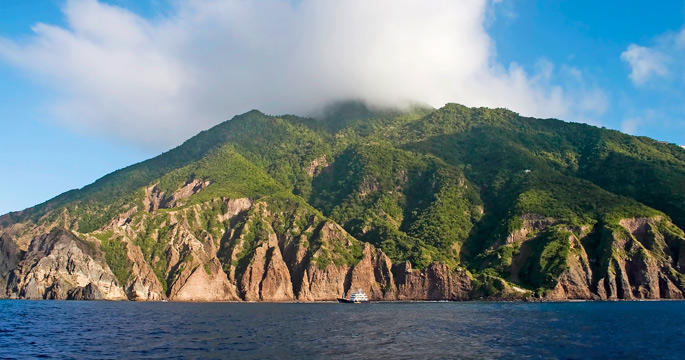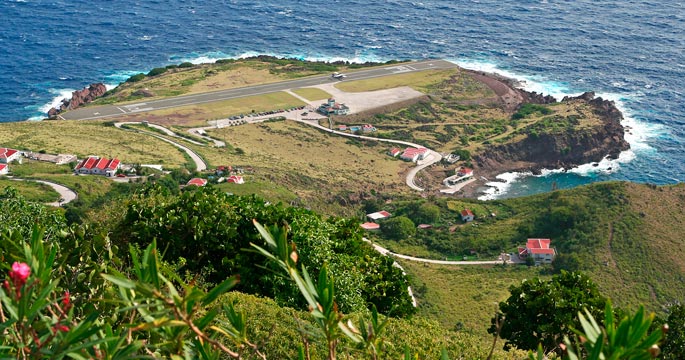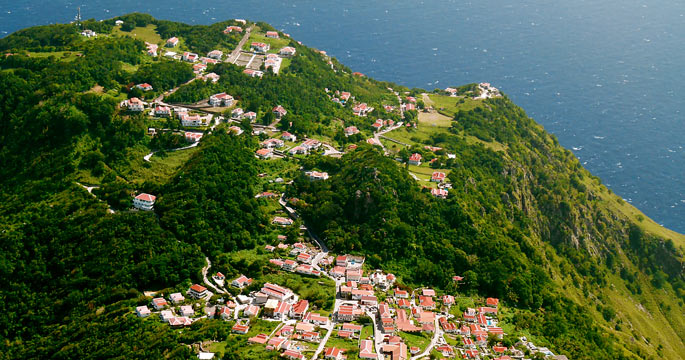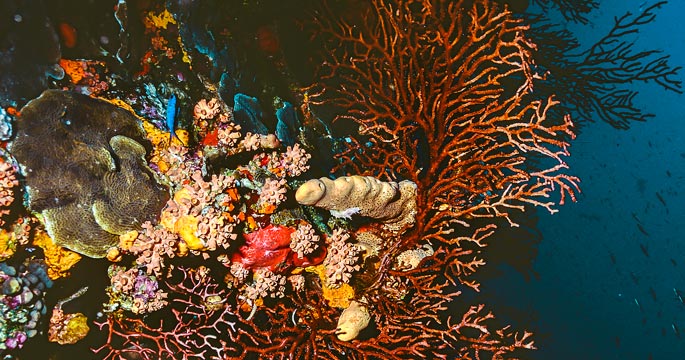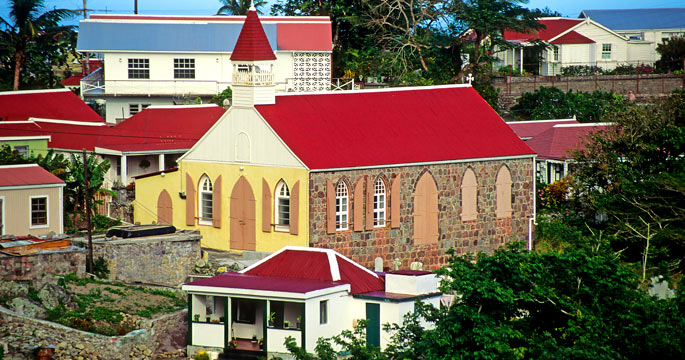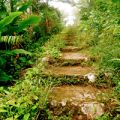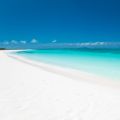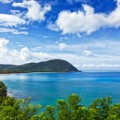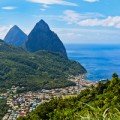Affectionately known as the Unspoiled Queen, the tiny island of Saba is unlike any other in the Caribbean. In fact, if you didn’t know better, you might think you were somewhere off the coast of California on one of the Channel Islands. On this smallest of the Dutch Windwards, nature reigns and eco-tourism is the big draw. The hiking is superb, big views are everywhere and the surrounding waters are pristine and protected. You won’t find any casinos, mega-all-inclusive resorts or a Margaritaville on this spoonful of paradise, just small cottage-style resorts, a close-knit community and a strong bond with nature.
1 Vertical Life
The island of Saba is the above-water remains of an extinct volcano, rising abruptly from the depths. There are no palm-lined beaches, no coastal lowlands to support a port city, and no fringing reefs to create a sheltered harbor. Instead, the shoreline transitions abruptly to precipitous bluffs that extends to the mist-shrouded heights of Mount Scenery. The almost total verticality of the landscape led settlers to create a collection of small villages set along the slopes within and a saddle valley near the island’s center. The surrounding hillsides and summit remain in a natural state.
2 Underwater World
The same precipitous volcanic topography that makes Saba unique above the waves continues below the surface, resulting in an underwater landscape that’s far different from other islands in the area. Instead of surrounding coral reefs, the bottom unfolds in a series of undercut ledges, seamounts and pinnacles. With blue close to shore, these structures not only hold a population of resident reef dwellers, but also attract passing oceanic species that can include sharks, dolphin and even whales. Snorkelers and scuba divers have more than 25 sites to enjoy, some suitable for novices and others best left to the experienced.
3 Charming Villages
There was a time when all island houses had to be white with green shutters and trim and red tile roofs. Though no longer a mandate, most structures remain true to those colors, creating a storybook setting against the verdant backdrop of the island’s slopes. Gardens are cared for religiously and relentlessly. Many residents are members of the local garden club, keen to be recognized for their varieties of hibiscus or the size of the blooms on a prized night-blooming cactus. Yards and gardens are overflowing with botanicals and stonewalls are draped with flowers in white, yellow and purple. Most yards have white picket fencing entwined with flowering vines.
4 Movie Magic
Vintage movie buffs might recognize Saba’s profile as Skull Island, the home of King Kong, as shown in the opening scene of the original 1930s version of the film. Not only was the fog-enshrouded silhouette of Saba used as a backdrop, several of the movie’s jungle scenes were filmed on the slopes of the island’s upland rainforest. Today, the same rugged landscape where your imagination could easily conjure a giant ape is more likely to yield trekkers and rock climbers.
5 Saba Marine Park
Saba became a regional leader in marine conservation with the establishment of the Saba National Marine Park in 1987. The park encompasses the surrounding waters of the entire island from the shore to a depth of 200 feet, covering an area of some 3,200 acres. Mooring buoys are set at more than two dozen dive sites to prevent anchor damage, spearfishing is banned and a snorkel trail is maintained at Torrens Points. Today, the park is managed by the Saba Conservation Foundation, and the underwater landscapes and fish populations are among the healthiest in the Caribbean.
6 Sea and Learn
During the month of October the island hosts an international group of naturalists and scientists to lead and participate in a range of programs that are free and open to visitors and locals alike. Activities include informal lectures, guided outings and the chance to engage in actual field research and nature surveys. Each day is rounded out with a series of interactive multi-media presentations on topics ranging from sharks and sea grasses to orchids and spiders. The roster changes each year, but the themes always appeal to the eco minded.
7 Mount Scenery
It wasn’t until 1943 that “the roadway that couldn’t be built” was carved into the island’s mountainous terrain by an enterprising local carpenter, accomplishing what Dutch engineers had deemed impossible. Until then, islanders connected with other villages by way of foot trails that crisscrossed the slopes. Today, these same footpaths are trekked by hikers who can choose from 14 routes that are both challenging and invigorating. Check in with The Trail Shop for directions and advice. You can go it alone with a map, join one of their organized hikes or book a private hike. At 2,855 feet, Mount Scenery is the highest point in the Kingdom of the Netherlands.
8 The Lace Ladies
The art of lace making involves the repeated tying of free threads by hand to create intricate patterns. It is believed to have come to Saba in 1870, when island resident Gertrude Johnson learned the craft while attending a convent school in Caracas. From that, a cottage industry was born. In those days women were sometimes left alone on the island while their husbands traveled abroad as sailors. The ladies would create the designs for tablecloths, napkins and other linens and sell their handcrafts via mail to countries around the world. Today the art is fading, but you can still find local handiwork at shops around the island.
9 Ride of your life
Simply getting to Saba is an adventure. A seaside lava flow that is the only significant flat spot on the island has been carved into a 1,300 foot landing spot that has the distinction of being the shortest commercial runway in the world. Flights from St. Maarten, which is just 12 minutes away, begin with little drama, but upon approaching the island the intensity escalates as the plane begins a landing approach parallel with rocky cliffs. Those on the right side of the plane can almost reach out and touch the rocks, while left-side passengers look down on the ocean just yards away.
10 Big Birding
More than 87 species of birds make their way to the island of Saba. Some are resting during a migration, while others find a suitable habitant for a season. There are Zenaida doves, bridled quail and red- necked pigeons but the more exotic are purple throated hummingbirds and their close relative, the Antillean crested hummingbird, which find plenty of sustenance among the nectar-laden blossoms that nature provides. Hike along the slopes of Mount Scenery and you’ll be assured to sight pearly-eyed thrashers, brown tremblers and purple- throated carob, while bananaquits make their way toward civilization. One of the island’s main ornithological claims to fame is the protected red-billed tropicbird that nests on the coastal cliffs.

